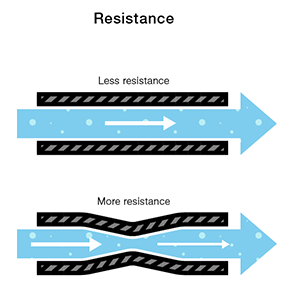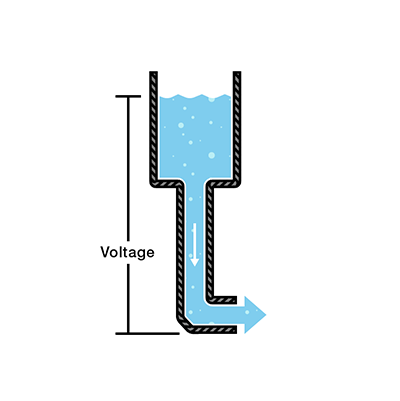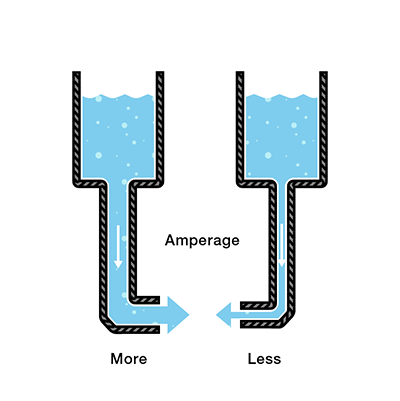Unit 6 Reflection Charges and Electricity
Equations you should know
Coulomb's Law
F=K*q1q2/d^2
Ohm's law
V=IR or I =V/R
Power
Power = current*voltage
Voltage = change in PE / q
Electric field = E = F/q
UNITS
F=Force
V=Voltage
A=Current
I=resistance
q=charge
Charge
The central theme of this unit is something called charge, which is the imbalance of electrons and protons. Electrons and protons are both charged particles, electrons are negatively charged and protons are positively charged. How an object is charged is when it has two much or to little of either of these particles. An object is neutral when it has an equal amount of electrons and protons.
Electrons are a little special in this relationship because they are much much smaller than protons. Because their so small (and their on the outside of the atoms nucleus). It is much easier for them to move from one electron to another.
There are three ways that something can be charged: Contact, Friction and Induction.
Contact: When two objects touch and transfer electrons from one to the other.
Friction: When two objects rub together and one takes electrons form the other. Visualize taking off a beanie . Do the hairs on your head stand up, If they do than they are being repulsed because they are now positive. The beanie had stolen some electrons form the hair making both charged.

Induction: The process by which an object becomes charged, first by being polarized form a charged object (that is by not touching it) and then touching the object with a a different neutral object allowing the flow of the opposite charges (those not being attracted by the charged object not touching). Now the original object is no longer neutral and has a charge.
Voltage
One the first things that we learned in this unit was potential difference or voltage. Voltage is the difference between two points of electrically charged areas. Think of a water pipe, one end has a bunch of water in it the other end has no water, naturally the water will flow from the filed end over to the empty end. This is an excellent example of how Voltage works. The most important thing to know is that Voltage is measued across two points, from the point it flow form to the point it's going to to. We can also say that it is the energy given to each Coulomb of charge.
The equation of Voltage is change in potential energy over charge. (Potential Energy is the amount of energy a charge could have, it's measured in one point compared to voltages two)
THe written equation is below:
V = Change in PE / q
or
Volts (V) = Joules/ Coulombs
Current
Current is the charge that flows through the circuit from point a to point b. It's what Voltage pushes along.
Current is measured in Amps.
It's equation is Amps (A) = Coulombs/second
or
A = q/seconds
current flows through the electrons in a circuit form one place to another. So if voltage is turned off there is no current flowing.
AC/DC
There are two different types of current. AC (Alternating Current) and DC( Direct Current). As the names imply AC is current that alternates meaning that it switches directions. flowing on way along the wire and then the opposite way a moment later. DC current is (as it's name implies) direct meaning that it doesn't change direction and keep going the same way.
Resistance

This is what resist the flow of charge. Certain properties of a circuit will effect how easily a charge moves through it. The wider the wire the less resistance because the the electrons that flow though the wire constantly bump along the sides. The wider the side the farther they will go in without hitting a wall. Heat is another factor, the more heat you have the faster the electrons move. If you tried going through a room that had a bunch of people moving very quickly it would be pretty hard to get to the other side. So the higher the heat the higher the resistance. Also the longer the wire the more resistance the electrons will encounter because they will have a much longer way to go.
The units for resistance are Ohm's
Ohm's Law
Ohm's law states that current that passes through a conductor is directly proportional to the potential energy.
I =V/R
or
V= IR
V = Voltage
I = Current
R = Resistance
The Speed of Light
Do electrons really move the speed of light? No. Electrons move excruciatingly slow, instead it is the Energy/electric field that moves so quickly. Energy merely passes through the electrons ( and nudges them a little bit) so that it can get form point A to point B.
The electric company pumps something into your house to make your appliances run. What is pumped into you house? Electricity! But what about the electrons, there already in the wires, there in the stoves, lightbulbs, toasters, dishwasher, act. THey are always there in fact they help make up those things. Their all cluster around other clusters of Protons in a huge atom sea. Even if you touch a power line the electrons don;t move very much (only a little bit) but it's the energy that hurts you and that passes through you.
Coulomb's Law
How do changes in distance affect force?
Coulomb's Law or the inverse square law tells us that the closer the charge the stronger the force.
The mathematical formula of this is written below.
F = K*q1q2/d^2
An excellent example this is the ballon problem described above (in friction). You you rubbed the hair with the ballon and it stole some electrons the ballon then became negatively charged. If you were to put that negatively charged ballon next to a wall it would do something called polarization where the negative charge of the balloon pushes the negative charges of the wall away but pulls the positive charges closer. The wall's net charge is still zero the charges are simply seperated. Now the negative charges are much closer to the positive charges and so have a stronger attracting force than the farther away and repulsive negative forces.
Coulomb's law is also called the inverse square law because distance and force are inversely proportional to each other.
2d=1/4F
1/2d=4F
Electric Shielding
If you have say an Xbox and you want to keep it running well, then you will want to keep that metal box around it, because it serves a special purpose other than to just look good. THere is this thing that is called an electric field, everything from cars to VCR's have an electric shield. THis thing is a conductor that stops charges from entering a certain area and damaging the delicate things inside (I.e. humans, circuitry). It does this by distributing the charge equally over the conductor. If a charge is the same (positive on positive, negative on negative) then they would naturally repulse each other. So the positive or negative charge will push themselves away from each other and around the conductor. Now the charges are pulling on every single part of the inside of the conductor, which means that even if the inside is oppositely charged than the outside. The inside is still neutral. Even if you have a negative charge closer to one wall then the other. Due to Coulomb's law the outside charges closer to that inside charge pull harder than the charges on the opposite side. But there are more charges pulling the negative on the opposite side, so neutrality is conserved.
The equation for electrical shielding difference is E=F/q
Power
Power is the rate by which something does work.
It's formula is Power = VI
The units of Power are joules per second or the watt
Parallel and Series
There are two types of circuits along current can flow, Parallel and series circuits.
Series is the more simpler of the two. It's just a simple circuit with one or two light bulbs attached in side by side. Because of this current has only one pathway that it can pass through. The resistance of these bulbs is the sum of each individual bulb.Voltage is also evenly distributed amongst the bulbs so that if you add them up they would equal the voltage of the source.
Each bulb Total
V=12v V=IR
=3(2)
= 6v
R= 2 +2 R=2 ohm's
=4
I = V/R I=I
= 12/4 =6v
=3A

Parallel circuits are when you take two or more bulbs and attach them so that each bulb has it's own pathway to the battery. This makes it so that if one bulb blows the other can still run because it will have it's own own full circuit to the battery. The total resistance in a parallel circuit is half the resistance of one of the bulbs. Voltage remains the same always (this is why it glows brighter than series). And the current of a bulb adds up to the total.
the following is true about parallel circuits
Each bulb Total
R= 2ohm's R= 1/2 (2) =1 ohm.
I = V/R I = V/R
= 12/2 = 12/1
= 6A = 12A
V= 12v V=12v
Fuse
A fuse is a small device that is inserted on a circuit so that it can stop the flow of current if it gets to high. When the fuse gets to hot it will melt and stop the flow of current.
What I liked
I really liked this unit because it was interesting to find out how electricity actually powers the things that we own. Like other physics units it's really applicable to everyday life and it's interesting to think about.
What I would do better next time.
I'm goeing to try and pay attention a lot more during labs, I often feel like I don't get very much done or I just don't know whats going on and so i'm left feeling confused.















